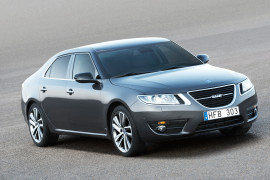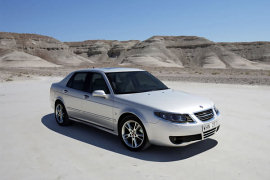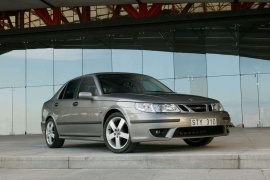SAAB 9-5 Models/Series Timeline, Specifications & Photos
First production year: 1997
Engines: Gasoline, Diesel, Hybrid, Ethanol
It was the last Saab 9-5 designed under GM management. It was the swan song of the former glory of the Swedish automotive that was based on aviation technology.
It was announced in September 2009 at the Frankfurt Motor Show. The world economic crisis was on the rise and the future of the European brands owned by General Motors was unclear. In January 2010, Spyker bought the Saab but the lack of liquidity closed the factory. Only 11.280 units were built.
The styling was streamlined, in the old fashion of the Saab specific design with a dropped, sloped end. The platform was taken from GM. It was the same platform used by GM on the Opel Insignia, Buick LaCrosse, or Chevrolet Malibu. The front grille had the same airplane theme. The headlights followed the same Saab theme used on the 1994 Saab 900 NG. In the rear, an LED light-bar went across the back, connecting the taillights. It was an unusual feature for a 2009 car.
Inside, there were the specific Saab controls and its classical night panel button that turned off all the lights and dials and left only the speedometer on. The head-up display was taken from the aviation industry. The GM already had that feature on several models, and it was an option for the 9-5.
There were few engine options, with four or six cylinders. The inline-four was front-wheel-drive while the V6 was all-wheel-drive. The 9-5 was offered with a choice of 6-speed manual or a 6-speed automatic.
SAAB introduced a facelifted version for the 9-5 lineup in 2005, and, somehow, it managed to ruin the car's design without improving it or lowering the production costs, as the company's owner, GM, asked.
The American automaker asked the Swedish brand to integrate more GM features into its cars and thus lowering the costs and making it more competitive in the market. But somehow, the reality was lost in translation, and the result was an even more expensive vehicle without offering significant upgrades other than the ones required by the switch to Euro5 standards, which were mandatory in Europe starting from January 2005.
The car's front fascia sported new chromed trims around the headlights, resembling a pair of goggles, which looked like they were added aftermarket by a clueless customer. Only one horizontal slat from the grille was chromed, supporting the carmaker's badge, and the rest were kept unpainted. However, the car's profile still followed the Swedish brand design language. Its sloped rear windscreen and the raised deck were already specific for SAAB.
Inside, Saab took more interior parts from GM's bins. Still, their squared shapes needed to integrate better with the rounded shapes of the dashboard. The car's wide instrument cluster extended over the center stack and continued on the center console. There were no significant upgrades in the back compared to the non-facelifted version.
Under the hood, Saab installed a choice of seven engines, and two of them were fueled with ethanol. But, unfortunately, that bold idea didn't match the market's needs.
Saab introduced the 9-5 in 1997, and in 2001 it introduced the first facelifted version, a much-needed modification due to the European pollution norms.
In 2001, Europe switched to Euro 3 pollution norms, and they lasted until January 2006. As a result, more measures were applied to Saab's flagship model.
From the outside, there were some minor cosmetic changes to the car. There was a new bumper design, depending on the trim level or the vehicle version. For the Aero versions, an A-shaped grille in the lower bumper area made the car looks more aggressive. The rest of the range featured a more refined, elliptic grille with fog-lights enclosed. Since there were such minor changes, Saab introduced a retro-fit kit for its customers to make their cars look younger.
Inside, Saab installed a few particular features specific to its brand. The key-fob was placed between the front seats, in front of the handbrake. But one of the most appreciated features was the "Night Panel" function. That led only the speedometer lit so that the unnecessary lights wouldn't put more stress on the driver's eyes. These particular details were inspired by jet-fighters, Saab making a big noise about its aviation heritage. Depending on the trim level, the car featured high bolstered seats at the front. In the back, it was a two-seat profiled bench.
GM had the Saab brand under its roof at that time. It supplied most of the engines and the technical platform. The 9-5 customers could choose from a wide range of gasoline and diesel engines. The 2.3-liter turbocharged unit was unique for the Swedish brand, while most of the others were carried over from GM's European branch, Opel.
The Saab 9-5 represented Saab's replacement for the 9000 model discontinued in 1997. The new model was produced in the same year, in two body versions: wagon and sedan. The car was considered a strong rival for the time’s Audi A6, BMW 5 Series or Mercedes-Benz E Class. The SAAB 9-5 had a long 12 years life before being replaced by a newer model.
While both body versions were very spacious inside, the wagon was mostly bought by people who wanted space and an easy loading feature, the car being equipped with a slide out boot floor.
The car was available with 4 engine choices: 2.0-liter and 2.3-liter gasoline, a 3.0-liter V6 gasoline and a 2.2-liter diesel unit. Except for the V6 engine, the others were fitted with a manual transmission. From 2001, the 4-speed automatic was replaced by a 5-speed automatic gearbox.
The V6 engine was later replaced with a 4-cylinder producing 220 hp. Saab upgraded it and by 2006, its power was increased with 40 hp, reaching 260 hp.
The car was well known for its safety features, being equipped with SAHR (Saab’s active head restraints) and the front seats had torso and head airbags, a rare feature for the 90’s.
The 9-5 was also used as a police car in Sweden and the UK, the Aero version being the preferred one due to its powerful engine developing a high torque. The Aero version was able to outperform a contemporary Porsche 911 Turbo between 40 to 90 mph.



